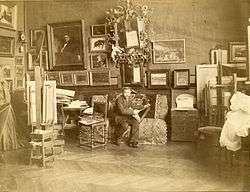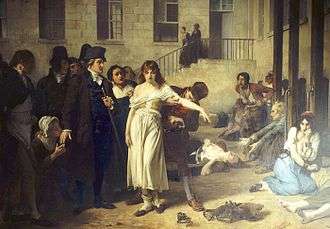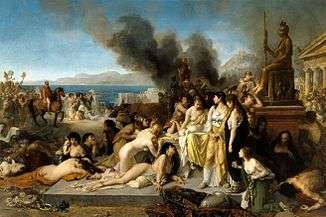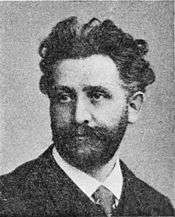Tony Robert-Fleury
| Tony Robert-Fleury | |
|---|---|
|
Photograph by Franz Benque | |
| Born |
September 1, 1837 Paris |
| Died |
December 8, 1911 (aged 74) Paris |
| Nationality | French |
| Known for | Painting |
Tony Robert-Fleury (1 September, 1837 – 8 December, 1911)[1] was a French painter, known primarily for historical scenes. He was also a prominent art teacher, with many famous artists among his students.
Biography
He was born just outside Paris, and studied under his father Joseph-Nicolas Robert-Fleury and under Paul Delaroche and Léon Cogniet at the École des Beaux-Arts (School of Fine Arts) in Paris.
His first painting at the Salon de Paris, in 1866, was a large historical canvas, titled Varsovie, Scene de l'Insurrection Polonaise, recalling the events of April 8, 1861 in Warsaw, when Russian troops quenched riots by force. In the following year, his "Old Women in the Place Navone, Rome" was purchased by the Musée du Luxembourg.

from the Frick Collection
In 1870, he painted a canvas of Le Dernier Jour de Corinthe (Last Day of Corinth), which depicted the last day before the Roman legions looted and burned the ancient Greek city, according to Livy. This painting was also purchased by the Musée du Luxembourg, it is on display at the Musée d'Orsay. In 1880, he painted a ceiling for the Luxembourg Palace in Paris, representing "The Glorification of French Sculpture."
Robert-Fleury painted Pinel a la Salpêtrière (1876), which depicts the famed Father of Modern Psychiatry among the inmates of the asylum. Philippe Pinel in 1795, had been named chief doctor at the asylum, he had instituted more charitable and rational treatments, without chains.
In 1875, Robert-Fleury painted Charlotte Corday at Caen, which shows the woman coming to the passionate conclusion that Marat needed to be murdered. In 1882 he painted Vauban donnant le plan des fortifications de Belfort where the celebrated engineer is represented in Louis XIV costume reviewing maps and designs, while in the background laborers engage on building.[2]
Robert-Fleury taught as professor for many years at the Académie Julian in Paris.[3][4]
Robert-Fleury became president of the Société des artistes français in succession to Bouguereau. He was honoured with Commander of the Legion of Honour in 1907.[1] In 1908 he was elected president of the Taylor Foundation, a position he held until the end of his life. He acquired a great reputation and is renowned for his historical compositions, portraits and genre scenes; at his atelier he taught several well-known painters of the late 19th and early 20th centuries from various countries, including Lovis Corinth, Édouard Vuillard and Sir George Clausen.
Gallery
 Varsovie, Scene de l'Insurrection polonaise
Varsovie, Scene de l'Insurrection polonaise Pinel at the Salpêtrière. Pinel orders removal of chains from patients at Paris Asylum for insane women.
Pinel at the Salpêtrière. Pinel orders removal of chains from patients at Paris Asylum for insane women. Le Dernier Jour de Corinthe, 1870
Le Dernier Jour de Corinthe, 1870
Pupils
Some of Robert-Fleury's more prominent pupils were:[5]
- Louis Abel-Truchet
- Jules Adler
- Cuno Amiet
- Jean-Franck Baudoin
- Amélie Beaury-Saurel
- Michel Emmanuel Michel Benner
- Marie Bashkirtseff
- Anna Bilińska-Bohdanowicz
- Paul Blondeau
- Corrie Boellaard
- Franklin Brownell
- Maurice Chabas
- George Clausen
- Lovis Corinth
- Jean Crotti
- André Des Fontaines
- André des Gachons
- Louis Cécile Descamps-Sabouret
- Louis-Marie Désiré-Lucas
- Etienne Dinet
- Robert Freiherr von Doblhoff
- Edouard Doigneau
- Jean-Gabriel Domergue
- Karl Dørnberger
- Mattie Dubé
- Alex Federley
- Horazio Gaigher
- Karl Gampenrieder
- Gustave Greux
- Otto Hamel
- Édouard-Louis Henry-Baudot
- Jules Héreau
- Emil Benediktov Hirschfeld
- Michel Korochansky
- Georges Pavec
- Ker Xavier Roussel
- Guillaume Seignac
- André Suréda
- Henry Valensi
- Pauline Vallayer-Moutet
- Édouard Vuillard
- Herbert Ward
- Viktor Zarubin
References
| Wikimedia Commons has media related to Tony Robert-Fleury. |
-
 This article incorporates text from a publication now in the public domain: Chisholm, Hugh, ed. (1911). "article name needed". Encyclopædia Britannica (11th ed.). Cambridge University Press.
This article incorporates text from a publication now in the public domain: Chisholm, Hugh, ed. (1911). "article name needed". Encyclopædia Britannica (11th ed.). Cambridge University Press.
- 1 2 French Ministry of Culture, National Archives: Document of Commander of the Legion of Honour
- ↑ Auber, Eugene (1894). Tony Robert-Fleury, The Art Journal, Volume 56. London: The Art Union. pp. 321–325.
- ↑ Collier, Peter; Lethbridge, Robert (1994). Artistic Relations: Literature and the Visual Arts in Nineteenth-century France. London: Yale University Press. p. 50. ISBN 9780300060096.
- ↑ "ROBERT-FLEURY, Tony". Benezit Dictionary of Artists. (subscription required (help)).
- ↑ "Tony Robert-Fleury". Netherlands Institute for Art History.
